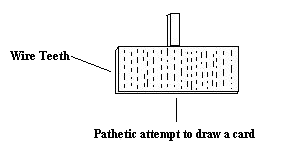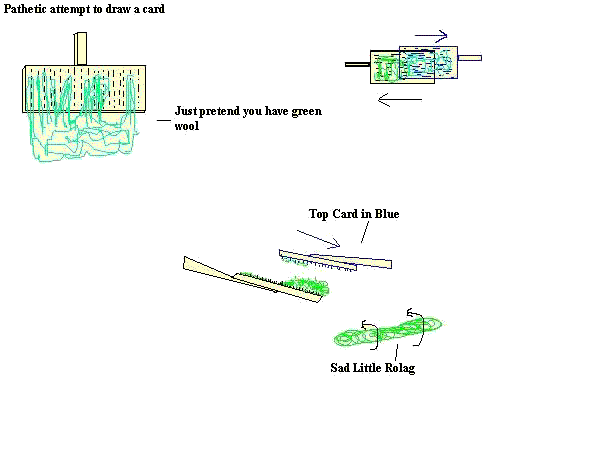I wholly endorse tossing the sheep into a nearby body of water and scrubbing around a bit, but not everyone raises sheep. I think doing that to someone else's sheep is illegal. Besides, not every nearby body of water is clean enough to wash wool in, sadly.
Most people (the ones reading this website, anyway) don't have access to sheep, and therefore don't shear them...so we'll just leave that bit out. You will most likely buy wool somewhere, already washed. If it isn't, here's what you do:
Get two large tubs, and fill them with warm water, add some mild soap. You'll need about four gallons of water for every pound of fleece. It is very important that you be gentle with the fleece, it can tear and get all knotty and ick to work with otherwise. Gently submerge the fleece in the water (don't pour the water over the fleece) and gently squeeze until the water is dirty. Shift the fleece to the second tub, already prepared with water and soap. If dirt sticks in the tip of the locks, gently use your fingernail to work it loose. Squeeze and release, squeeeeeeze and release, gently massage the life back into those knotty curls....umm, yeah.
Gently (are you sensing a pattern here?) rinse the fleece, and place it on a bug-free, rust proof screen to dry.
Sheep produce lanolin, which keeps the wool nice and soft. It also works wonders on your skin, which is why lanolin is in so many lotions. Keeping some lanolin in your wool helps your finished product to repel water,so it's a good thing all around. Once you've washed your fleece, you should spray a small amount of lanolin and water on it to keep it conditioned. Thinning down some lanolin-based lotion works just fine. Let the fleece stand overnight before you use it.
Now, you don't have to stick with just wool. You can use cotton, llama hair, silk, rabbit fur...just about anything will work, but wool is the easiest to work with. As far as I know, wool is the cheapest and easiest to procure...at least in the southwest USA. If you can't find it in stores, check your local 4H club. If all else fails, shave your cat and try that. :)

After you've cleaned your wool, but before you can spin it, you need to card and organize it. Carding is basically brushing your wool to remove knots and any bits of foreign matter. A card is a rectangular wire brush with a small handle...if you've ever been in a stable, you know what I mean.
Cards have different sized mesh for different types of fibers...medium weight wool, for example, would take a number eight card. Ask at a farmer's co-op or 4H for more information on types of cards.
To begin carding, tease the fleece by telling it that it's mother dresses funny. Or just tease it by seperating the fibers gently. Your choice.
Take a handful of teased fleece and pull it along the teeth of your card so that fiber catches fairly evenly. Pull the upper card across the fleece, slowly and gently. Stroke the cards together a few times until you have about half of the wool on each card. Gently transfer the wool back and forth between the cards, removing bits of non-wool as you go. Keep carding until the fibers are thick, fluffy, evenly distributed, and fairly knot-free, then start pulling the fibers onto the bottom card. Then, using the top card, pull the wool down to the bottom of the bottom card. Gently shake the wool from the card and roll between the palms of your hands to form a rolag (a loosely rolled tube-like length of wool). You'll need at least ten good sized rolags before you start spinning.

And that's that. You may now learn to use a drop spindle. Ta daa!
Was the explanation clear enough? If not, let me know. Remove the "nospam" before sending.
